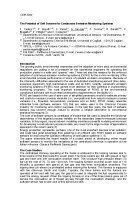Air Monitoring
The Potential of Soft Sensors for Continuous Emission Monitoring Systems
Oct 06 2014
Author: F. Callero, P. Moretti, C. Parisi, A. Servida, F. Corona, R. Baratti, P. Bragatto, P. Pittiglio and C. Codevico on behalf of CEM
Introduction
The growing public environmental awareness and the adoption of more strict environmental regulations are putting a lot of pressure on the operational engineers for operating the production plants in a safer and “greener” way. These are also the reasons for the enforced adoption of continuous emission monitoring systems (CEMS) for the on-line monitoring of the environmental process performance in terms of pollutant emission compliance. Because of the inherently difficulties associated to the use of dedicated analytical equipment (time delay, expensive equipment, high maintenance costs, and so forth), recently, parametric emission monitoring systems (PEMS) have gained more attention for their potential in implementing monitoring programs. The most important advantage of PEMS is the environmental compliance achieved with much less burdensome requirements on the facility (1).
PEMS are based on the use of some sort of simplified parametric model to estimate primary and costly-to-measure process variables (i.e., compositions) from easy-to-measure process variables (i.e., flowrates, temperatures, pressures and so forth). PEMS closely resemble inferential tools (software sensors, SS) that are widely used in the Chemical Process Industry for monitoring and control purposes. In the last few years, the field of software sensors has become enough mature to provide a reliable alternative to conventional analytical techniques (2).
The core of software sensors is constituted of models that are used to describe the functional dependence of the targeted process variable on the secondary (easy-to-measure) process for developing non-structured process models, as proved by the large number of applications appeared in the recent years (3).
Energy production represents, perhaps, one of the most important sources of air pollution, and could take great advantage from adopting in an efficient way PEMS based on software sensors for improving the operation efficiency of combustion systems (1, 4).
The paper describes the recent results of a project aimed at developing online neural software sensors to monitor the emissions at the centralized chimneys in operation at two Italian refineries (Saras e Raffineria Sannazzaro).
Digital Edition
AET 28.2 April/May 2024
May 2024
Business News - Teledyne Marine expands with the acquisition of Valeport - Signal partners with gas analysis experts in Korea Air Monitoring - Continuous Fine Particulate Emission Monitor...
View all digital editions
Events
Jul 30 2024 Jakarta, Indonesia
China Energy Summit & Exhibition
Jul 31 2024 Beijing, China
2024 Beijing International Coal & Mining Exhibition
Aug 07 2024 Beijing, China
IWA World Water Congress & Exhibition
Aug 11 2024 Toronto, Canada
Aug 25 2024 Stockholm, Sweden and online






.jpg)








